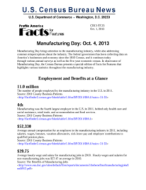Facts for Features: Manufacturing Day: Oct. 4, 2013
Manufacturing Day brings attention to the manufacturing industry, highlighting new technologies and innovations while also addressing common misperceptions about the industry. The federal government has been collecting data on America's businesses and economy since the 1810 Census, and it continues today through various annual surveys as well as the five-year economic census. In observance of Manufacturing Day, the Census Bureau presents a special edition of Facts for Features that highlights various statistics throughout the manufacturing industry.
Employment and Benefits at a Glance
11.0 million
The number of people employed by the manufacturing industry in the U.S. in 2011.
Source: 2011 County Business Patterns
<//factfinder2.census.gov/bkmk/table/1.0/en/BP/2011/00A1//naics~31-33>
4th
Manufacturing was the fourth largest employer in the U.S. in 2011, behind only health care and social assistance, retail trade, and accommodation and food services.
Source: 2011 County Business Patterns
<//factfinder2.census.gov/bkmk/table/1.0/en/BP/2011/00A1>
$52,330
Average annual compensation for an employee in the manufacturing industry in 2011, including salaries, wages, bonuses, vacation allowances, sick-leave pay and employee contributions to qualified pension plans.
Source: 2011 County Business Patterns
<//factfinder2.census.gov/bkmk/table/1.0/en/BP/2011/00A1//naics~31-33>
$29.75
Average hourly wage and salary for manufacturing jobs in 2010. Hourly wages and salaries for non-manufacturing jobs was $27.47 on average in 2010.
Source: The Benefits of Manufacturing Jobs
<//www.esa.doc.gov/sites/default/files/reports/documents/1thebenefitsofmanufacturingjobsfinal5912.pdf> [PDF - <1.0 MB]
Manufacturing by State
5
Number of states with more than 500,000 manufacturing jobs in 2011 (California, Texas, Ohio, Pennsylvania and Illinois). Total employment from those five states account for 32.5 percent of all manufacturing jobs.
Source: 2011 County Business Patterns
<//factfinder2.census.gov/bkmk/table/1.0/en/BP/2011/00A1/0100000US.04000/naics~31-33>
13.1 percent
Share of total employment in Indiana that comes from manufacturing jobs in 2010, the highest of any state. Following Indiana was Wisconsin (12.9 percent), Iowa (10.6 percent), Arkansas (10.6 percent) and Ohio (10.0 percent).
Sources: The Benefits of Manufacturing Jobs
<//www.esa.doc.gov/sites/default/files/reports/documents/finalthegeographicconcentrationofmanufacturingacrosstheunitedstates.pdf> [PDF - 1.1 MB]
22.3 percent
Share of total earnings in Indiana that comes from manufacturing jobs in 2010, the highest of any state. Following Indiana was Wisconsin (20.2 percent), Iowa (17.6 percent), Michigan (16.8 percent) and Ohio (16.0 percent).
Source: The Benefits of Manufacturing Jobs
<//www.esa.doc.gov/sites/default/files/reports/documents/finalthegeographicconcentrationofmanufacturingacrosstheunitedstates.pdf> [PDF - 1.1 MB]
26
Manufacturing was one of the top three employers in 26 states in 2011.
Source: 2011 County Business Patterns
<//factfinder2.census.gov/bkmk/table/1.0/en/BP/2011/00A3/0100000US.04000>
Consumption and Production
$716.9 billion
Total cost of materials the petroleum and coal products manufacturing industry consumed in U.S. manufacturing in 2011, which was the most of any industry. Other industries that had a high cost of materials include food manufacturing ($448.2 billion), transportation equipment manufacturing ($433.4 billion) and chemical manufacturing ($406.7 billion).
Source: Annual Survey of Manufactures 2011
<//www.census.gov/manufacturing/asm/>
$3.2 trillion
Total cost of materials for all U.S. manufacturing industries in 2011.
Source: Annual Survey of Manufactures 2011
<//www.census.gov/manufacturing/asm/>
$836.8 billion
Total value of shipment of goods from the petroleum and coal products manufacturing industry in 2011, which was the most of any industry. Other top industries by value of shipments included chemical manufacturing ($776.8 billion), food manufacturing ($710.4 billion) and transportation equipment manufacturing ($690.4 billion).
Source: Annual Survey of Manufactures 2011
<//www.census.gov/manufacturing/asm/>
$5.5 trillion
Total value of shipment of goods for all U.S. manufacturing industries in 2011.
Source: Annual Survey of Manufactures 2011
<//www.census.gov/manufacturing/asm/>
Manufacturing Role in Trade
59.7 percent
Of the total known dollar value of U.S. exported goods in 2011, 59.7 percent came from the manufacturing industry. By comparison, wholesale industries accounted for 22.9 percent of the total known value of U.S. exported goods, while 16.9 percent came from all other industries.
Source: A Profile of U.S. Importing and Exporting Companies, 2010-2011
<//www.census.gov/foreign-trade/Press-Release/edb/2011/edbrel.pdf> [PDF - <1.0 MB]
24.4 percent
Of identified companies in the U.S. that engaged in exporting in 2011, 24.4 percent of the companies were from manufacturing-related industries.
Source: A Profile of U.S. Importing and Exporting Companies, 2010-2011
<//www.census.gov/foreign-trade/Press-Release/edb/2011/edbrel.pdf> [PDF - <1.0 MB]
44.3 percent
Of the total known dollar value of U.S. imported goods in 2011, 44.3 percent were from companies in the manufacturing industry. By comparison, wholesale industries accounted for 31.4 percent of the total known value of U.S. imported goods, while 23.8 percent came from all other industries.
Source: A Profile of U.S. Importing and Exporting Companies, 2010-2011
<//www.census.gov/foreign-trade/Press-Release/edb/2011/edbrel.pdf> [PDF - <1.0 MB]
19.8 percent
Of identified companies in the U.S. that engaged in importing in 2011, 19.8 percent of the companies were from manufacturing-related industries.
Source: A Profile of U.S. Importing and Exporting Companies, 2010-2011
<//www.census.gov/foreign-trade/Press-Release/edb/2011/edbrel.pdf> [PDF - <1.0 MB]
The following is a list of observances typically covered by the Census Bureau’s Facts for Features series:
| Black (African American) History Month (February) Super Bowl Valentine's Day (Feb. 14) Women's History Month (March) Irish-American Heritage Month (March)/ St. Patrick's Day (March 17) Earth Day (April 22) Asian/Pacific American Heritage Month (May) Older Americans Month (May) Mother's Day Hurricane Season Begins (June 1) Father's Day |
The Fourth of July (July 4) Anniversary of Americans With Disabilities Act (July 26) Back to School (August) Labor Day Grandparents Day Hispanic Heritage Month (Sept. 15-Oct. 15) Unmarried and Single Americans Week Halloween (Oct. 31) American Indian/Alaska Native Heritage Month (November) Veterans Day (Nov. 11) Thanksgiving Day The Holiday Season (December) |
Editor’s note: The preceding data were collected from a variety of sources and may be subject to sampling variability and other sources of error. Facts for Features are customarily released about two months before an observance in order to accommodate magazine production timelines. Questions or comments should be directed to the Census Bureau’s Public Information Office: telephone: 301-763-3030; or e-mail: pio@census.gov.







